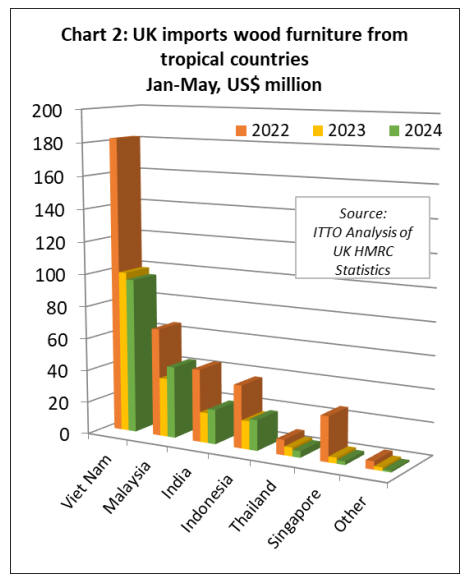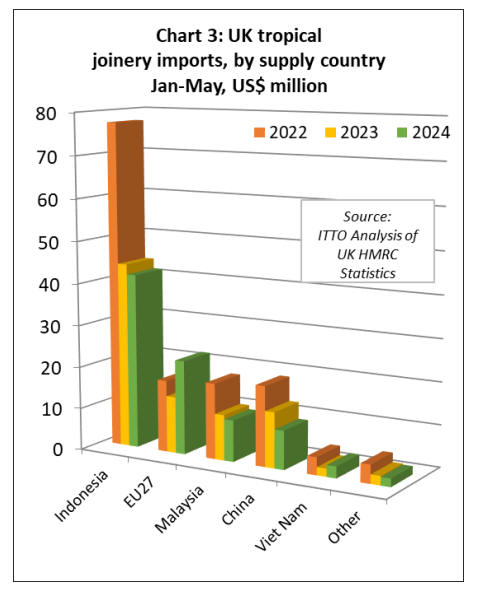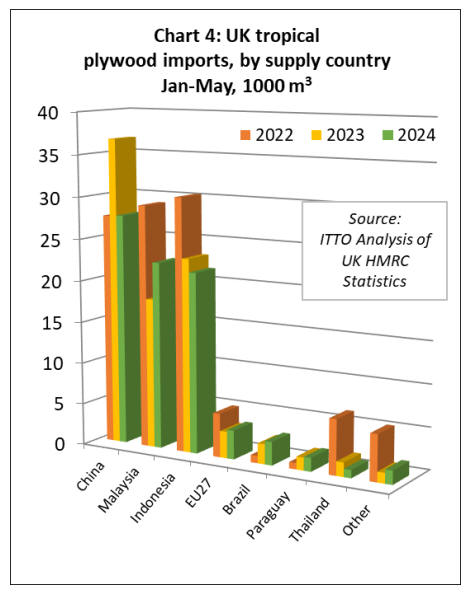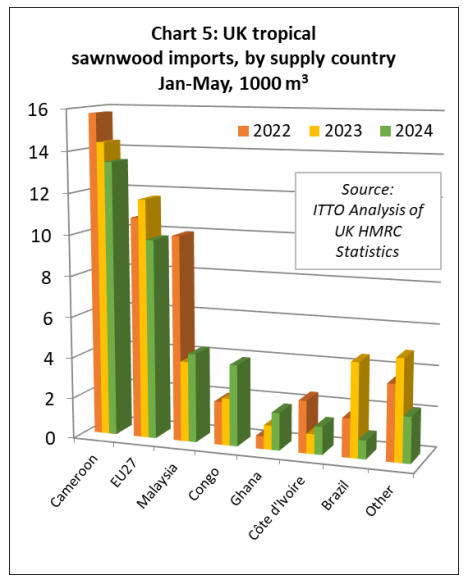|
Report from
Europe
Weak start to the year for UK tropical wood imports
but outlook improving
After hitting an all-time low in 2023 and starting this year
very slowly, UK imports of tropical wood products
showed some early signs of recovery in April and May.
This mirrors trends in the UK construction sector and in
the wider economy which have gained a little momentum
this year.

The UK imported 159,600 tonnes of tropical wood and
wood furniture products with a total value of US$408
million in the first five months of this year.
In tonnage terms, this was 5% less than the same period
last year, but gains were made in March and April after
imports fell to an all-time low in the previous three month
period (Chart 1 above). Import value in the first five
months of 2024 was marginally up - by 0.4% - compared
to the same period in 2023.
UK imports of tropical wood furniture rise from the
depths of last year
UK imports of wood furniture products from tropical
countries in the first 5 months of 2024 were a marginal
improvement on the same period in 2023. The UK
imported US$187 million of these products between
January and May this year, 2% more than the same period
in 2023. In quantity terms, wood furniture imports were
49,700 tonnes in the first five months of 2024, 4% more
than the same period in 2023.
In the five months this year compared to the same period
in 2023, UK wood furniture import value increased from
Malaysia (+22% to US$44.2 million), India (+14% to
US$21.2 million), and Indonesia (+8% to US$18.8
million).
However, imports were down from the largest supplier
Vietnam (-4% to US$95.6 million), as well as from
Thailand (-25% to US$4 million), and Singapore (-40% to
US$2.1 million). UK wood furniture imports were
negligible from all other tropical countries during the
period (Chart 2).

UK imports more tropical hardwood joinery from the
EU
In the first five months this year, the UK imported 29,700
tonnes of tropical joinery products with value of US$87.9
million. Compared to the same period in 2023, import
quantity was 3% less while import value increased by 3%.
A very large rise in the value of imports of joinery
products made with tropical wood from the EU (+66% to
US$22.4 million) and a recovery in imports from Vietnam
(+43% to US$2.8 million) offset falling imports from
Indonesia (down 5% to US$41.7 million), Malaysia (down
9% to US$9.9 million) and China (down 30% to US$9.2
million) (Chart 3).

UK imports of tropical plywood shift from China and
Indonesia to Malaysia
In the first five months of 2024, the UK imported 82,300
cu.m. of tropical hardwood plywood, 7% less than the
same period last year. Import value also declined 7% to
US$49.2 million.
UK imports of plywood with a tropical hardwood face
veneer from China were 27,700 cu.m. in the first five
months of this year, 25% less than the same period in
2023.
Tropical hardwood plywood imports fell by 7% from
Indonesia to 21,600 cu.m. and by 43% from Thailand to
1,000 cu.m. during the five-month period. However,
hardwood plywood imports increased from Malaysia
(+25% to 22,400 cu.m.), Brazil (+16% to 2,800 cu.m.),
and Paraguay (+7% to 1,600 cu.m.) between January and
May this year. Indirect imports from the EU also
increased, by 8% to 3,500 cu.m. during the five-month
period (Chart 4).

Sharp drop in UK imports of tropical sawnwood from
Cameroon and the EU
UK imports of tropical sawnwood were 37,900 cu.m. in
the first five months of 2024, 14% less than the same
period last year. Import value was US$46.5 million in the
January to May period, 2% less than the same period in
2023. However, the pace of imports did pick up pace in
the April and May after a very slow start to the year.

In the first five months of this year compared to the same
period in 2023, UK sawnwood imports from Cameroon
were down 7% to 13,400 cu.m, while indirect imports
from the EU fell 17% to 9,800 cu.m. Imports from Brazil
also fell sharply, by 80% to 900 cu.m.
However, there were gains in UK imports of sawnwood
from Malaysia (+11% to 4,400 cu.m.), Republic of Congo
(+73% to 4,000 cu.m.), Ghana (+56% to 1,800 cu.m.), and
Cote d’Ivoire (+42% to 1,400 cu.m.) (Chart 5).
The UK imported 3,600 tonnes of tropical hardwood
mouldings/decking with a total value of US$10 million in
the first five months of 2024, respectively 2% and 9% less
than in the same period last year. Imports of this
commodity recovered ground from Indonesia, the UK’s
largest supplier, in the first five months of this year (+17%
to 1,345 tonnes).
However, imports were down from the EU (-10% to 756
tonnes), Brazil (-12% to 140 tonnes), and Vietnam (-41%
to 130 tonnes). Imports from Malaysia were unchanged at
1,100 tonnes during the five-month period (Chart 6).

Hints of UK construction recovery, but true turnaround
not expected until 2025
The Glenigan Construction Index for August 2024
provides an analysis of UK construction activity for the
three months ending in July 2024, focusing on projects
valued at £100m (USD$128 million) or less. The report
offers insights into the construction sector's performance
over the past year, with findings seasonally adjusted.
The construction sector has seen a modest improvement
despite being down 11% compared to 2023. There was a
2% increase in starts for the three months ending July
2024, marking the first industry-wide uptick in months.
This improvement is largely driven by private
housebuilding growth.
The report notes that increased private housing starts
reflect growing market confidence. However, social
housing and non-residential sectors remain subdued due to
political changes and government reviews of major
programmes.
Overall, residential construction increased by 12% during
the three months to July 2024, despite being 17% lower
than a year ago. Private housing starts rose by 25%,
reflecting improved market sentiment, although they
remain 12% below last year's levels. Social housing starts
fell by 23% from the previous three months and 32% from
last year.
Civil construction rose by 9% over the last three months
and 14% year-on-year, driven by a 21% increase in
infrastructure project starts. The utilities sector fell by 8%
from the previous three months and 16% from last year.
The industrial sector decreased by 10% in the past three
months and 34% year-on-year.
The UK Construction Products Association’s (CPA) latest
state of the market report takes a more downbeat
perspective. Its summer forecast published end of July
downgrades the building sector’s near-term growth
prospects. Output is forecast to fall by 2.9% this year,
steeper than the 2.2% contraction forecast three months
ago.
“This is primarily due to recovery in the two largest
construction sectors, private housing new build and repair,
maintenance and improvement (rm&i), being pushed back
until the Bank of England begins cutting interest rate cuts
and consumer confidence strengthens,” says the CPA. “In
addition, increasing concerns about the potential impact of
uncertainty around responsibilities throughout the whole
construction supply chain from the Building Safety Act
may also delay delivery of some larger, high-rise projects.
The sector’s recovery, it states, is now forecast to be in
2025, with growth of 2.0% and a further rise of 3.6% in
2026 as the lagged impacts of lower interest rates combine
with sustained real wage growth, improving consumer and
business confidence, as well as greater economic and
political certainty as the new government develops its
spending plans.
After last year’s double-digit fall, the CPA forecasts UK
private housing output will fall by a further 7.0% in 2024,
followed by a rise of 6.0% in 2025.
Private housing repair, maintenance and improvement is
forecast to fall by 6.0% this year, with 2.0% growth in
2025. However, energy-efficiency retrofit, and solar
photovoltaic work has continued to remain strong, whilst
building safety activity continues to provide a steady
pipeline of activity.
Despite the overall construction decline forecast for 2024,
the outlook for construction sectors outside of housing
remains similar to three months ago, with many firms
operating in commercial refurbishment and fit-out or
working on major infrastructure projects continuing to
experience robust activity.
Commenting on the Summer Forecasts, CPA Head of
Construction Research, Rebecca Larkin said it was still too
early to say what the impact of the recent election of a
Labour government on construction would be or when its
commitment to new house building will start to impact the
market.
“Off the back of the election there have been clear signs of
intent from the new government, particularly around
potential changes to planning policy to improve housing
and infrastructure delivery,” said Ms Larkin. “However,
with little detail at this stage, it is difficult to see any near-
term uplift, whilst long-running concerns over skills
shortages and the loss of construction workers, which has
worsened dramatically in recent years, present the biggest
risk to longer-term growth.”
See: https://www.glenigan.com/market-analysis/industry-
news/
and
https://www.constructionproducts.org.uk/news-media-
events/news/2024/july/cpa-summer-forecasts/
New government commits to housing drive
The King’s Speech to parliament, laying out the new
Labour government’s policy plans, included the pledge to
increase social and affordable housing, with a target of 1.5
million new dwellings in five years.
Promising “the biggest increase in social and affordable
housebuilding in a generation,” the government pledges
to:
Immediately update the National Policy Planning
Framework restoring mandatory housing targets
Ensure that planning authorities have up-to-date
Local Plans and reform and strengthen the
presumption in favour of sustainable
development
Take a “brownfield” first approach, prioritising
the development of previously used land
wherever possible, and fast-tracking approval of
urban brownfield sites
Prioritise the release of lower quality ‘grey belt’
land, as well as introducing ‘golden rules’ to
ensure greenbelt development benefits
communities and nature
Creating several new towns, as previously
announced in late May
Further reform compulsory purchase
compensation rules to speed up delivery
Strengthen planning obligations to ensure new
developments provide more affordable homes
and prioritise the building of new social rented
homes
Source https://www.pbctoday.co.uk/news/planning-construction-
news/kings-speech-signals-next-wave-construction/142733/
|